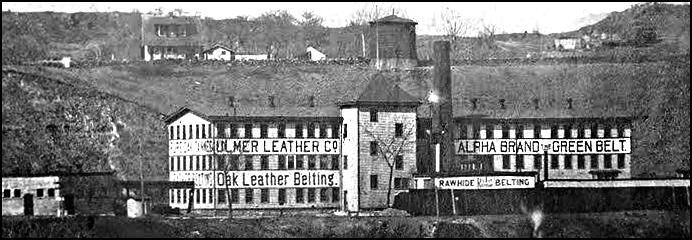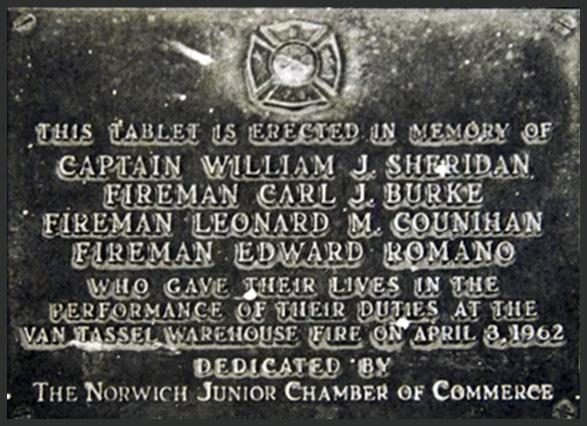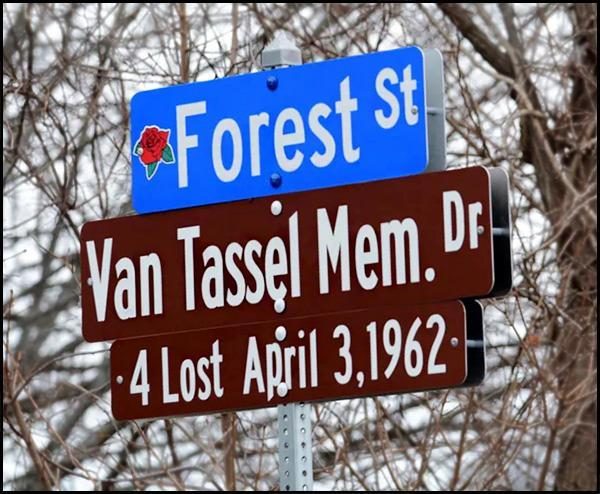1956 Taftville's Sacred Heart Church Fire
On April 29, 1956 a fire devastated the people of Taftville. It was on a Sunday, at the 8 o’clock Mass. The Reverend Henri Laurion smelled smoke, as did most of the parishioners at Sacred Heart that morning. He turned on the altar and announced to the congregation that they should leave the church in an orderly manner, that the church was on fire.
At first, it looked like a minor incident, but Sacred Heart Church had so many appointments that were flammable. There were velvet ropes surrounding the altar and there were decorative wooden columns. It was a magnificent altar, but that morning, it would fuel a fire that would ultimately destroy the church.
The thick fog that morning made for an eerie sight as the people left the church. Several in the congregation were volunteer firemen, and with the fire house just a block up Merchants Avenue, they ran to sound the alarm and get the firefighting equipment. What followed was the greatest demonstration of volunteerism ever seen in Taftville.
Volunteer firemen quickly arrived on the scene from everywhere. The following, in no particular order, joined Taftville at the scene: Yantic, East Great Plain, Occum, Jewett City, Lisbon, Willimantic, Sub Base, Groton Borough, Konomoc (New London), Montville, Mohegan, Joseph Perkins, Central, Baltic, Laurel Hill, Poquetanuck, Preston City, Pachaug, Voluntown, Bozrah, Andover, Columbia, South Windham, North Windham, Eagleville and Mansfield. In all, more than 200 firefighters responded with approximately 30 pieces of equipment from 26 companies.
*Place cursor over any image to magnify
Though the fight was futile, there was more fire equipment in Taftville that day than ever before or since. If manpower and hard work could have saved the church, it would have survived.
Acknowledgements
“Once Upon A Time: When Church Burned, Taftville Mourned,” 08/01/2010, by Bill Stanley
“Bill Stanley’s Once Upon A Time: Book I,” p 76, (1993)
The complete list of sources may be found by clicking the “Bibliography” button, and, then typing “Sacred Heart fire” in the SEARCH box.
1958 Mount Pleasant Convent Fire
Father Francis Eagan built Saints Peter and Paul Catholic church in 1938. It was the first Catholic Church on Norwich’s West Side. Only four years later, Father William J. Baldwin was named pastor of the church. He worked with the congregation’s youth through athletic and social programs.
By the late 1950s, Father Baldwin was using the Mount Pleasant School for catechism, but he dreamed of having a complete catholic school conveniently located next to the church on Elizabeth Street.
However, the school would need nuns as teachers and a convent to house them. His dreams began to take shape after he convinced the State of Connecticut to donate an unused building that could be converted into a convent and a recreation center. A wooden-framed building at the State of Connecticut’s Uncas-on-Thames facilities was chosen and moved in pieces to the empty lot on Elizabeth Street just below where the rectory stands today.
*Place cursor over any image to magnify
After the building was reconstructed and renovated, it was ready to serve its noble purpose. On the Saturday night before the future convent’s dedication Father Baldwin and other parish leaders set the furniture in place, swept the floors, and gathered up all remaining debris. The discarded matter was placed and burned in the fireplace located in the center of the convent’s main room. Having finished their work, everyone left for home.
It was a windy night, as the photos show, and gusts of wind came down the chimney, blowing the embers from the fireplace onto the floor. By the time anyone arrived, the whole structure was engulfed, the roof collapsed, and the fire was out of control.
Norwich’s uniformed firemen arrived, but there was nothing they could do. The entire building burned to the ground. It all happened very quickly, and everyone at the scene, though there were only a few because of the late hour, knew how much hard work and how many dreams had just gone up in the smoke and flame of the fire.
Acknowledgements
“Bill Stanley’s Once Upon A Time: Book I,” ppg 82-83, (1993), “Fire Snuffed out Monsignor Baldwin’s Dream”
“Norwich Rites for MSGR. Baldwin,” Catholic News Archive, Vol. LXIX, Number 51, 04/29/1977
The complete list of sources may be found by clicking the “Bibliography” button, and, then typing “convent fire” in the SEARCH box.
1962 Van Tassel Warehouse Fire
A terrible explosion in Norwich took the lives of four uniformed Norwich firemen. At that point in time, it was the worst loss of lives in the history of Connecticut among firemen at a single fire.
The Thames Belting Company, (formerly the Ulmer Leather Company), shared a large portion of its building with the Van Tassel Leather Company. Van Tassel used its portion of the building as a warehouse. The 1912 map below-left shows the general location of the warehouse, and the photograph on the right was taken in 1938, when the building was used by the Ulmer Leather Company.

Ulmer Leather Co. - 1938
On April 3, 1962 personnel at the Van Tassel Leather Company warehouse had recently unloaded chemicals. While they were unloading the chemicals on the platform, one of the containers had broken in transit was leaking. The ensuing chemical reaction generating extreme heat, which the driver of the truck noticed. He knew the truck and the warehouse were filled with highly explosive chemicals, so he ran into the warehouse and told everyone to leave because there was going to be an explosion.
After someone called the fire department six firemen promptly arrived on the scene. Knowing the danger, they took a position behind a 4-foot high, solid concrete retaining wall for protection. After directing a blast of water from their fire hose onto the fire, an explosion beyond all belief occurred.
1962 – Van Tassel Warehouse on Fire
A dramatic account leading up to, and immediately following, the April 3 explosion and fire that snuffed out the lives of four Norwich firemen appears in the July Quarterly issue of the National Fire Protection Association, International.
The account, based on the personal investigation of the explosion on the afternoon it occurred, was written by Miles E. Woodworth, National Fire Protection Association, a flammable liquids specialist. Woodworth noted that the incident illustrates the dangers of modern-day shipping practices, the hazards of inadequately marked cargo and the difficulty of firefighting in loaded type-van trailers.
Woodworth wrote: “The following facts are known. Forest Street slopes toward the warehouse and ends in a severe bump. The chemical truck, having passed over this bump, sat for over 35 minutes in the plant yard with the motor running before it was backed into the loading platform between 12:50 and 12:55 p.m.
Woodworth theorizes that, possibly, the impact from the bump on Forest Street or the shifting of the load in transit spilled organic peroxide, which may have been ignited by friction between containers in the van.
A much more complete account of Woodworth’s report is provided in the document shown below.
Heat was so intense that it melted a fire truck
Fire Lt. Thomas LaFreniere, having survived the explosion, heads back into the blaze to help his buddies. Police Sgt. John Sisco pursues LaFreniere who is suffering shock.
*Place cursor over any image to magnify

The photos above pay tribute to the fallen firefighters who gallantly performed their duty on April 4, 1962. The Bibliography (below) contains many articles that tell of the devastating consequences to their families and many other Norwich citizens.
At that time, there were no laws in Connecticut or ordinances that required of warehouses, but after the tragedy, many new laws and regulations were passed. It is little comfort to the families, but the tragic deaths of their loved ones changed how chemicals are now stored safely throughout the United States.

NOTE: The primary intent of this IconicNorwich.org article is to provide an overview of the events. Please use the “Bibliography” button below to find many articles about the incident that have been written over the past 60 years.
Acknowledgements
“Van Tassel Tragedy,” 1962, by Norwich Firefighters Local 892
“Four Norwich Firemen Killed by Explosion,” 1993, by Bill Stanley
The complete list of sources may be found by clicking the “Bibliography” button, and, then typing “Van Tassel fire” in the SEARCH box.
*Place cursor over any image to magnify
1963 Spaulding Pond Dam Collapse
Mohegan Park and Spaulding Pond have been a place of tranquility and pleasure for more than a century. The Spaulding Pond Dam has kept the water in place for more than fifty years. The postcard shown of the left shows how the pond appeared in the fall of 1957.
The winter of 1962-1963 was severe and by early March heavy rains were melting a layer of glacial ice that was two-feet thick in places. On the afternoon of March 5 personnel from the City Public Works Department inspected the dam, looking for leaks. There was a concern for the safety of the dam because seepage had been observed in previous years.
View of arbor (circa 1913)
View of dam (circa 1913)
Inspectors found that water was seeping through the dam’s earthen core. The director of the Public Works personally inspected the dam at 6:15 pm and confirmed there indeed was leakage. However, he saw no trace of erosion or other conditions symptomatic of imminent danger.
Unfortunately, his assessment was erroneous. Only a few short hours later, at 9:20 pm he contacted the Norwich police and informed them that the dam might collapse. At 9:25 pm a local radio station was contacted and requested to broadcast a city wide alert. At 9:27 pm the dam collapsed and sent a wall of water racing toward downtown Norwich.
*Place cursor over any image to magnify
On the crest of the wave were huge blocks of ice that worked like battering rams. Many of the blocks were that size of a kitchen table and were two-feet thick.
A local newscaster reported that the water in Franklin Square had been as much as five feet deep. Bill Stanley wrote : “The water on Bath Street and behind the Norwich Bulletin was like a huge lake.” The photo, shown on the left, was taken near Franklin Square in front of the Turner and Stanton Twine Mill.
At 10:14 pm several workers at the mill, unaware of the mortal danger that they were in, rushed upstairs to a window to see what all the commotion was about. It was a fatal error because a few moments later a 12-foot wall of water and ice washed away the lower floor of the mill.
Madlyn Atterbury, Helen Roode, Alexander Pobol, Anna Barrett and Mae Robidou all lost their lives as the mill collapsed.
Memorial to the Six Who Perished
Dedicated March 4, 2006
Several blocks north of Franklin Square, Ron Moody arrived home from work and warned his wife and family of the immanent danger. After telling them to evacuate his wife, Honey, gathered up their three sons to take them to her mother’s home in the western part of town.
The entire family, and their upstairs neighbor Tony Orsini, got into their car and Ron began driving. Just as they passed the Lake Street playground floodwaters floated their car off the road. Everyone made it safely out of the car but Honey. After she handed her infant son through the window to her husband, the car shifted and Honey was swept away into the freezing water. There was no chance for anyone to save Honey. She was found dead the next day 20 feet from the car.
The failed dam was originally built in 1853 by two businessmen and was later modified. The dam was used strictly for providing a controlled water supply to downtown Norwich. The water was needed to power waterwheels for local businesses. Virtually no safety factors were built into the design of the dam. Its failure was attributed to bad design, poor maintenance and no consideration of its potential harmful impact to the city.
Following the investigation and a restructuring of the town’s emergency response organization, the Spaulding Pond Dam was rebuilt. The demolition of the old dam’s remains began in August of 1964, and the large modern replacement dam being completed and dedicated in September of 1965.
*Place cursor over image to magnify
The new dam was mostly funded by the U.S. Department of Agriculture’s Soils and Conservation Service. It was built in accordance with the Watershed Protection and Flood Prevention Act of 1954. Today, it is a safe, well-maintained structure.
Acknowledgements
“A Swift and Deadly Maelstrom ; The Great Flood of 1963,” by Thomas Moody
“6 Died When Dam Bursts, Norwich Flooded,” 02/28/2010, by Bill Stanley
PicClick UK
Public Domain and Bruce Noland
The complete list of sources may be found by clicking the “Bibliography” button, and, then typing “Spaulding Dam” in the SEARCH box.